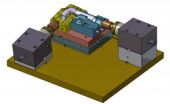(Press-News.org) At the Sixteenth International Conference on Miniaturized Systems for Chemistry and Life Sciences (microTAS) to be held Oct. 28-Nov. 1, in Okinawa, Japan, University of Cincinnati researchers will present four papers, including one detailing improvements in rare cell isolation and one detailing improvements, in terms of cost and time, of common blood tests.
Ian Papautsky, associate professor in UC's School of Electronic and Computing Systems (SECS), part of the College of Engineering and Applied Science, and a UC team are leading these research efforts.
In a paper titled "Continuous Rare Cell Extraction Using Self-Releasing Vortex in an Inertial Microfluidic Device" by Papautsky and co-authors Xiao Wang, UC doctoral student, and Jian Zhou, research associate, a new concept for separation of rare cells, such as prostate cancer cells or circulating tumor cells, using microfluidics, is detailed.
"Last year we showed we can selectively isolate prostate cancer cells, but only by running small sample volumes one at a time. Now we show that we can do this continuously," Papautsky said. "This is exciting because it allows for an entire blood draw to be processed, in continuous matter, in a shorter period of time."
These blood draws can be used to identify tumor cells for diagnostic or prognostic purposes. "Our approach is based purely on size. It doesn't rely on antibodies, which is important because not all cancer cells express antigens. So, if the cancer cells are, let's say, larger than 20 microns, we'll extract them," he explained.
The most common approach for looking for these circulating tumor cells is via a system that uses a selection using antibodies to detect antigens. "We could also use our device to prepare samples for systems that use antibody-based selection." This combined approach could potentially help reduce occurrence of false positives while significantly increasing the accuracy of the antibody-based tests.
Another area in which this device could be useful is in working with cell cultures. "If you have a mixture of multiple cells where some cells are small and other cells are big, we could separate these cell populations very easily," Papautsky explained. "Anytime you need to separate based on size, we can do it using inertial microfluidics."
The advantage of inertial microfluidics in cell separation is that it can be done easily and without cumbersome equipment. This research is leading to an entirely new generation of testing capabilities which particularly lend themselves to direct use in the field and in physicians' offices in just about any country and any economic setting.
In another paper, titled "Sorting of Blood in Spiral Microchannels" Papautsky and doctoral student Nivedita Nivedita demonstrate continuous sorting of blood utilizing inertial microfluidics via a simple passive microfluidic device. Papautsky's lab has been developing the concept of using inertia to manipulate cells and particles during the last few years. "It's truly different and innovative because these microfluidic devices are really low cost while offering very high throughput," said Papautsky.
The device is, essentially, a clear, plastic, flexible square that is relatively small in size, at about a half an inch across, but big in concept. "With this particular device we can take a drop of blood, put it in the input port in the center, and separate," Papautsky explained. The device contains four outlet ports which separate the blood into different streams, allowing the collection of outputs containing dilute plasma, red blood cells and white blood cells.
"There are a lot of clinical diagnostic tests that are based on blood," he said. One of the most common tests that are done in a hospital is the complete blood count (CBC). Through this test, a wide range of conditions like anemia, malaria or leukemia are diagnosed. "In all of these diagnostic tests, blood must be separated into its components, and that's what this device does," Papautsky explained. "So, instead of using a big centrifuge to do it, we can do it with this little device." Using the microfluidic device allows for a diagnosis in less time in a much easier fashion.
This quick, low-cost way of running a diagnostic test could potentially be used in a resource-limited setting. "One of the issues that I hear from my colleagues who work in these areas that do tests is that they have equipment," he said, "but don't always have personnel or stable power to operate them. So in places like India, Africa or Central America, our devices could be useful."
INFORMATION:
This work was supported by the DARPA Micro/Nano Fluidics Fundamentals Focus (MF3) Center at the University of California at Irvine.
New options for ease and accuracy in extraction of rare cells or separating blood
2012-10-26
ELSE PRESS RELEASES FROM THIS DATE:
Magnetic brain stimulation treats depression independent of sleep effect
2012-10-26
AUGUSTA, Ga. – While powerful magnetic stimulation of the frontal lobe of the brain can alleviate symptoms of depression, those receiving the treatment did not report effects on sleep or arousal commonly seen with antidepressant medications, researchers say.
"People's sleep gets better as their depression improves, but the treatment doesn't itself cause sedation or insomnia." said Dr. Peter B. Rosenquist, Vice Chair of the Department of Psychiatry and Health Behavior at the Medical College of Georgia at Georgia Health Sciences University.
The finding resulted from ...
Minimizing mining damage with manure
2012-10-26
This press release is available in Spanish.U.S. Department of Agriculture (USDA) research confirms that the time-tested practice of amending crop soils with manure also can help restore soils on damaged post-mining landscapes.
Thousands of acres of land with little or no vegetation, once mined for lead and zinc, remain throughout an area of southwestern Missouri, southeastern Kansas, and northeastern Oklahoma. The mining activities also left behind a legacy of lead-contaminated acidic soils, toxic smelter sites, and large quantities of mine tailings called "chat."
Soil ...
Mayo Clinic researchers develop new tools to better treat ADHD patients in early stages
2012-10-26
SAN FRANCISCO -- Mayo Clinic researchers are presenting new findings on the early treatment of child and adolescent attention deficit hyperactivity disorder this week at the American Academy of Childhood and Adolescent Psychiatry annual meeting in San Francisco. They include a method to get better input from parents and teachers of children who are being diagnosed with ADHD for the first time -- allowing for more effective treatment upon the first consultation. Researchers also showed how a tool can help clinicians better diagnose and treat children who have both ADHD and ...
Moffitt Researchers find genetic predictors of fatigue for some prostate cancer patients
2012-10-26
Researchers at Moffitt Cancer Center and the University of South Florida have found that men with prostate cancer who receive androgen deprivation therapy may predictably suffer from fatigue if they have single nucleotide polymorphisms in three pro-inflammatory genes. The discovery highlights the importance of personalized medicine, in which therapies are tailored to a patient's genetic profile.
The study appears in the October issue of Brain, Behavior, and Immunity.
"Few studies have examined the role of genes in cancer-related fatigue and none, to our knowledge, ...
ESDM early intervention improves brain activity associated with social cues
2012-10-26
(NEW YORK, N.Y., October 26, 2012) – The Early Start Denver Model (ESDM), a comprehensive behavioral early intervention program that is appropriate for children with autism spectrum disorder (ASD) as young as 12 months, has been found to be effective in improving social skills and brain responses to social cues in a randomized controlled study published online today in the Journal of the American Academy of Child & Adolescent Psychiatry.
"So much of a toddler's learning involves social interaction, and early intervention that promotes attention to people and social ...
Autism early intervention found to normalize brain activity in children as young as 18 months
2012-10-26
An intensive early intervention therapy that is effective for improving cognition and language skills among very young children with autism also normalizes their brain activity, decreases their autism symptoms and improves their social skills, a nationwide study has found. The researchers said the study is the first to demonstrate that an autism early intervention program can normalize brain activity.
"We know that infant brains are quite malleable and previously demonstrated that this therapy capitalizes on the potential of learning that an infant brain has in order ...
Feinstein Institute researchers discover that bean used in Chinese food could protect against sepsis
2012-10-26
MANHASSET, NY – Researchers at The Feinstein Institute for Medical Research have discovered that a bean commonly used in Chinese cuisine protects against the life-threatening condition sepsis. These findings are published in the current issue of Evidence-based Complementary and Alternative Medicine (eCAM).
It has been found that a deoxyribonucleic acid (DNA) protein, HMGB1, mediates inflammation. Inflammation is necessary for maintaining good health – without inflammation, wounds and infections would never heal. However, persistent and constant inflammation can damage ...
Results of the XIMA trial presented at TCT 2012
2012-10-26
MIAMI, FL – OCTOBER 26, 2012 – Rarely tested in patients over the age of 80, a study found that drug-eluting stents exhibited some benefits over bare-metal stents, though both types of stents demonstrated a clinical benefit. Results of the XIMA trial were presented today at the 24th annual Transcatheter Cardiovascular Therapeutics (TCT) scientific symposium. Sponsored by the Cardiovascular Research Foundation (CRF), TCT is the world's premier educational meeting specializing in interventional cardiovascular medicine.
Patients over the age of 80 are often excluded from ...
Cost-effective titanium forming
2012-10-26
To all intents and purposes, nothing stands in the way of titanium in terms of becoming a first-choice industrial material. It is a practically unlimited resource; it is stable and lightweight, but also extremely malleable as well as corrosion and temperature resistant. Nevertheless, this white silver lustrous metal remains in the shadows of steel, chrome, nickel and aluminum when it comes to manufacturing. The reason for this is that efficient metal forming processes such as deep drawing or hydroforming can only be used in a very limited way. "Titanium tends to adhere ...
A Viagra follow-up? Drug used to treat glaucoma actually grows human hair
2012-10-26
If you're balding and want your hair to grow back, then here is some good news. A new research report appearing online in The FASEB Journal (www.fasebj.org) shows how the FDA-approved glaucoma drug, bimatoprost, causes human hair to regrow. It's been commercially available as a way to lengthen eyelashes, but these data are the first to show that it can actually grow human hair from the scalp.
"We hope this study will lead to the development of a new therapy for balding which should improve the quality of life for many people with hair loss," said Valerie Randall, a researcher ...



